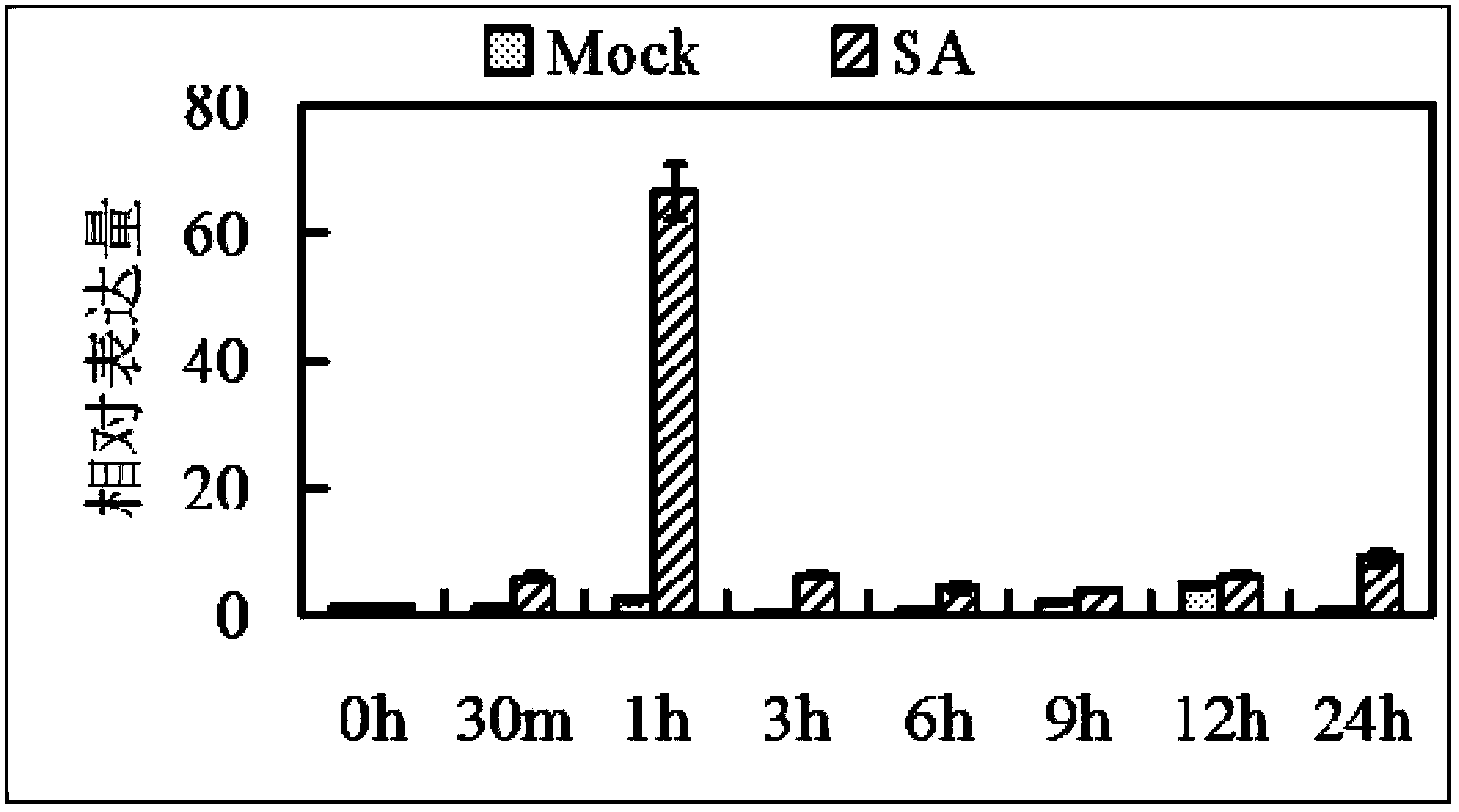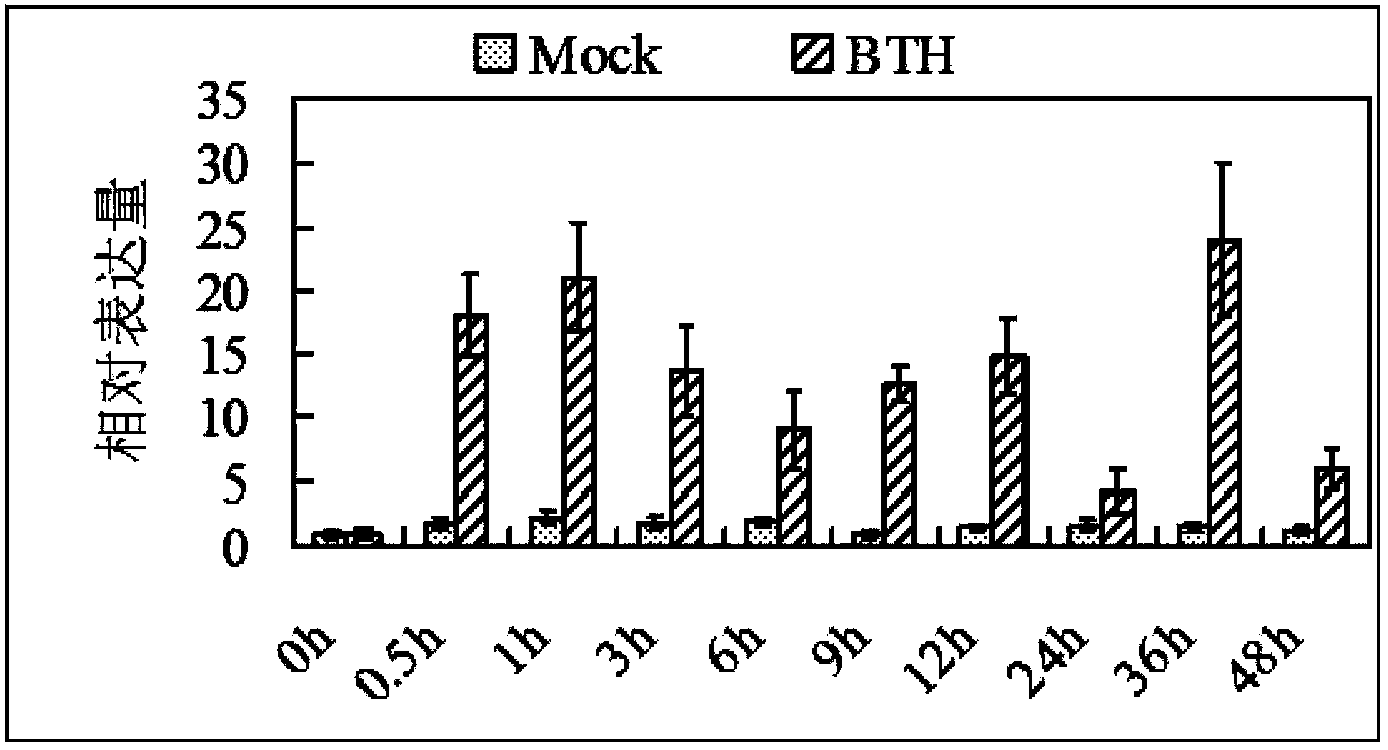Application of rice WRKY transcription factor gene OsWRKY21 in cultivation of resistant varieties of plants
A technology of transcription factors and disease-resistant varieties, applied in the field of agricultural biology, can solve the problems of failing to achieve disease resistance, difficult to counteract pathogenic microorganisms, and long breeding cycle, and achieve good disease resistance, broad-spectrum and specific protection.
- Summary
- Abstract
- Description
- Claims
- Application Information
AI Technical Summary
Problems solved by technology
Method used
Image
Examples
Embodiment 1
[0044] Example 1 Isolation and Cloning of OsWRKY21 Gene
[0045] Using rice variety Nipponbare (Luo Linguang et al. Genotype analysis of rice male sterile line Zhenshan 97A at heading stage. Acta Genetica Sinica, 2001, 28(11)) as material, three-week-old wild rice seedlings in normal soil culture were sprayed with Using Magnaporthe grisea strain 00-193a with strong pathogenicity and high pathogenic frequency in Guangdong Province (Ouyang Dongmei et al., Genetic analysis and gene marker mapping of Basmatic370 mutant BTX resistance to rice blast. Molecular Plant Breeding, 2009,7(1)) spore suspension (10 5 1 / mL), after 24 hours, use Trizol reagent (purchased from Invitrogen) to extract total RNA from successfully inoculated rice leaves (see Trizol manual for extraction method), and use reverse transcriptase M-MLV (purchased from Invitrogen) to synthesize the total RNA by reverse transcription The first strand of cDNA (for the method, refer to the manual of reverse transcriptase)...
Embodiment 2
[0064] Example 2 Expression profile analysis of OsWRKY21 gene
[0065] Using the rice variety Nipponbare as the material, three-week-old wild-type rice seedlings in normal soil culture were sprayed with 10 5 / ml of Magnaporthe grisea 00-193a spore suspension, 2 mM salicylic acid (SA), 0.5 mM benzothiadiazole (BTH) and 100 μM jasmonic acid (JA), all solutions were spiked with 0.05% (v / v) Tween20 was used to increase the adhesion of the leaf surface; the mock control group (mock) was sprayed with solvent components in various solutions respectively. The sampling time of blast fungus induction experiment is 0h, 6h, 12h, 24h, 48h, 72h. The sampling time of SA and JA treatment experiment was 0h, 0.5h, 1h, 3h, 6h, 9h, 12h, 24h. The sampling time of BTH treatment experiment was 0h, 0.5h, 1h, 3h, 6h, 9h, 12h, 24h, 36h, 48h. The total RNA of each sample was extracted with Trizol reagent (purchased from Invitrogen) (see the instruction manual of Trizol for the extraction method), and...
Embodiment 3
[0066] Example 3 Production and identification of disease resistance of transgenic rice overexpressed with OsWRKY21 gene
[0067] The pGEM-OsWRKY21 plasmid was digested with AscI and BamHI to obtain the full-length coding frame sequence of OsWRKY21, and the obtained OsWRKY21 gene full-length coding frame sequence was inserted into Figure 5 Between the AscI and BamHI restriction sites of the pFGC 1008 vector (Kerschen et al. Effectiveness of RNA interference in transgenic plants. FEBS letters. 2004, 566(1)) shown, the specific recombination steps refer to the restriction endonuclease of TaKaRa Company Enzyme and T4 ligase instructions, transform the recombinant plasmid into Escherichia coli strain DH5α, and the clone identified as positive by enzyme digestion contains the overexpression vector of OsWRKY21 gene.
[0068]The Nipponbare embryogenic callus was used as the transformation recipient, and the OsWRKY21 gene overexpression vector was introduced into the recipient materi...
PUM
 Login to View More
Login to View More Abstract
Description
Claims
Application Information
 Login to View More
Login to View More - R&D
- Intellectual Property
- Life Sciences
- Materials
- Tech Scout
- Unparalleled Data Quality
- Higher Quality Content
- 60% Fewer Hallucinations
Browse by: Latest US Patents, China's latest patents, Technical Efficacy Thesaurus, Application Domain, Technology Topic, Popular Technical Reports.
© 2025 PatSnap. All rights reserved.Legal|Privacy policy|Modern Slavery Act Transparency Statement|Sitemap|About US| Contact US: help@patsnap.com



